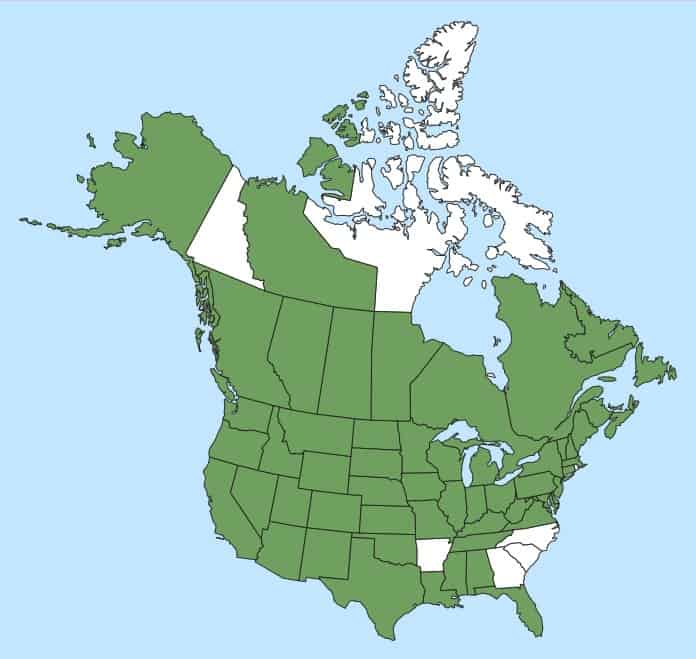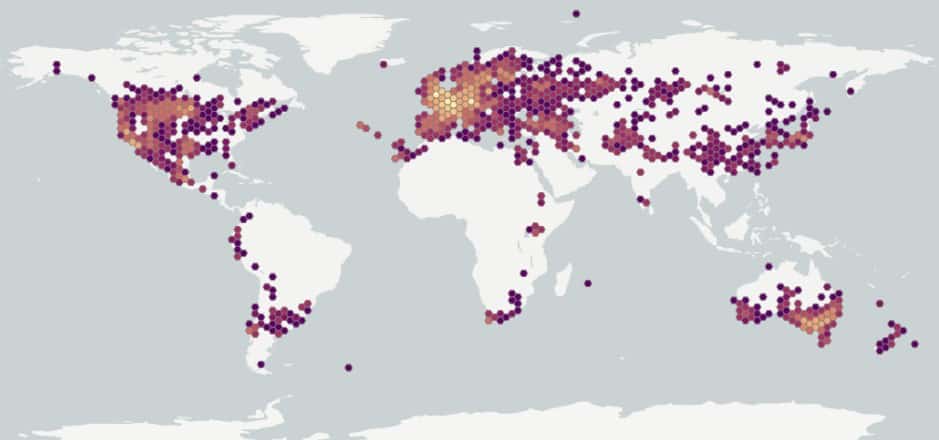Avena fatua
Overview
Aperçu
Regulation :
Remarques Réglementation:
- CFIA Weed Seeds Order - Class 3: Secondary Noxious Weed Seeds
Regulation Notes:
Distribution :
Répartition :
Native to Europe, northern Africa and central Asia (USDA-ARS 2021); associated with the cultivation of Avena sativa (oats) and other cereals since the Iron Age (CABI 2021). Introduced throughout temperate regions and present on all continents except Antarctica (CABI 2021; USDA-ARS 2021). Occurs throughout the United States, except in a few southeastern states (Kartesz 2015; USDA-NRCS 2021). Occurs across Canada except in Nunavut and is ephemeral in the Yukon (Brouillet et al. 2010+).
Habitat and Crop Association :
Habitat et Cultures Associées :
Cultivated fields, fallow fields, pastures, gardens, roadsides and disturbed areas (Sharma and Vanden Born 1978; Darbyshire 2003). A serious weed of cereals, oilseeds and legume crops, mainly associated with fertile soils and spring cereals, but it can be found on nearly all soil types in a wide range of cropping systems (Sharma and Vanden Born 1978; CABI 2021).
Economic Use, cultivation area, and Weed Association :
Utilisation économique, zone de culture et association de mauvaises herbes :
Duration of Life Cycle :
Durée du cycle vital:
Annual
Dispersal Unit Type :
Type d’unité de dispersion :
Floret
General Information
RENSEIGNEMENTS GÉNÉRAUX
Avena fatua has relatively large seeds and its dispersal is associated with the cultivation of cereal crops around the world (CABI 2021). In North America, it was introduced by early European settlers as a contaminant in seeds and animal feed, and the earliest record in Canada indicates it was present in Avena sativa (oats) cultivated in Newfoundland in 1622 (Sharma and Vanden Born 1978). Since then it has spread across the continent in cereals and other crops.
A single A. fatua plant typically produces 100-150 seeds, with reports of up to 500 seeds per plant depending on growing conditions (Sharma and Vanden Born 1978); seeds may remain viable for up to 14 years (CABI 2021).
.Identification
Identification
-
Spikelet
Size
- Spikelet length*: 18.0 – 32.0 mm (Barkworth et al. 2007)
Shape
- Spikelet is wedge-shaped
Surface Texture
- Spikelet surface is smooth with 9 – 11 longitudinal nerves
Colour
- Spikelet is dull straw yellow coloured
Other Features
- 2 – 3 florets in a spikelet, florets shed separately (Barkworth et al. 2007)
-
Floret
Size
- Floret length*: 7.6 – 18.8 mm; width: 1.4 – 2.4 mm
*Note: minimum and maximum of 17 florets in a normal range of this species using image measurement (ISMA 2020)
Shape
- Floret long oval shaped, pointed at the end opposite the callus
Surface Texture
- Floret has a granular surface
- Surface may have stiff brown hairs, but are generally removed during processing
Colour
- Floret is generally shiny reddish-brown with a straw yellow pointed end, can be straw yellow, dark brown or grey coloured
Other Features
Lemma awn
- A bent and twisted awn is attached to the upper 1/2 of the lemma, 30.0 – 40.0 mm long (Sharma and Vanden Born 1978)
Rachilla and Callus
- Rachilla is flat and strap-like, dull straw yellow coloured with a triangular-shaped tip, densely hairy
- Callus at the base of the floret is oval or egg-shaped, concave, surrounded by stiff, brown coloured hairs
Other Features
- The edges of the palea have numerous thin teeth
- Palea is generally covered by the lemma edges
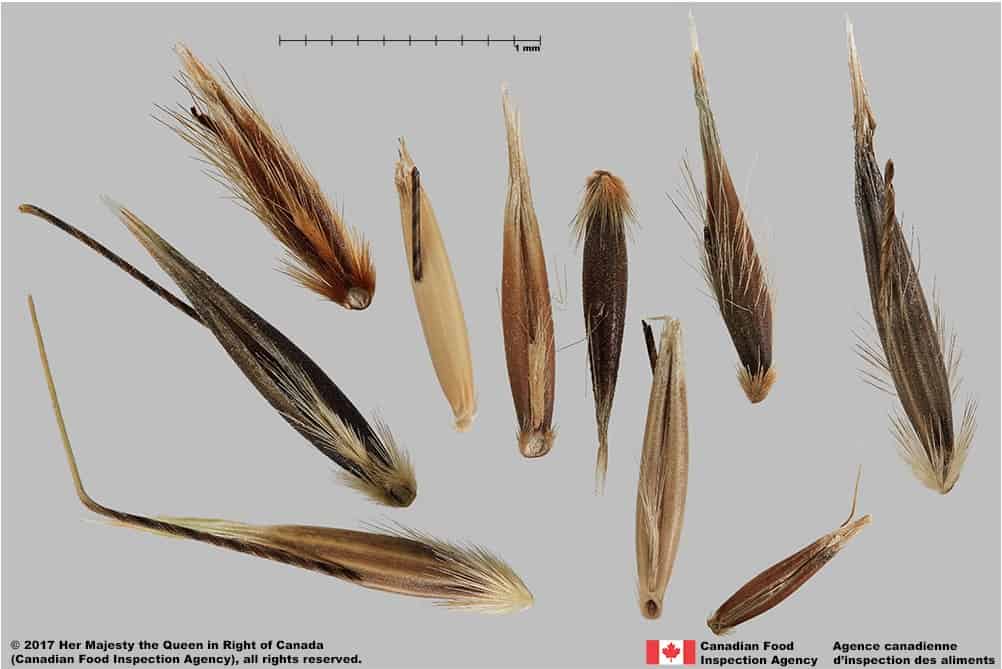
Wild oat (Avena fatua) florets


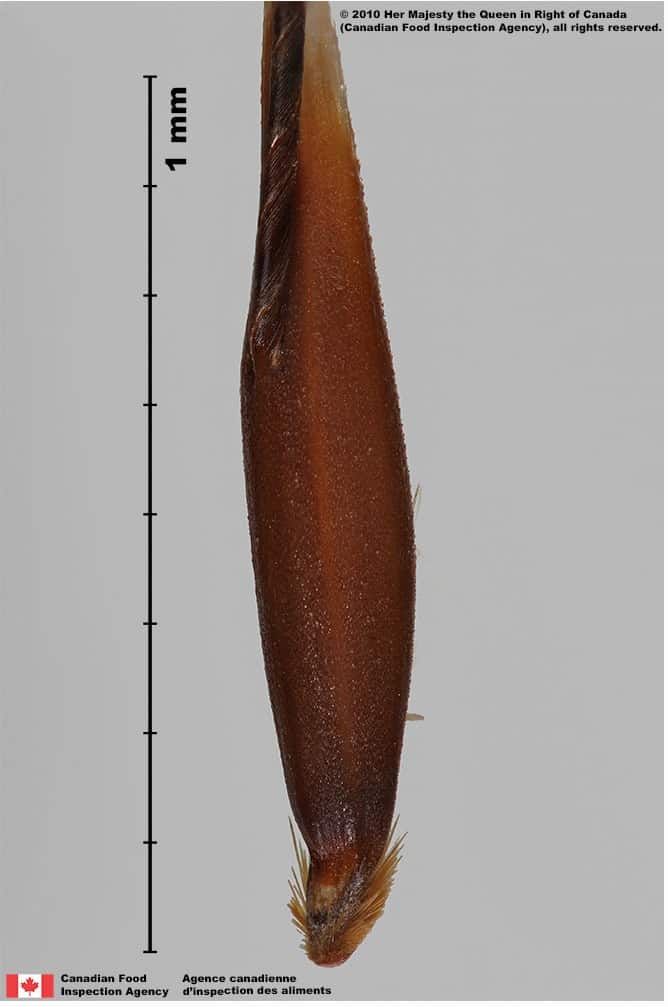
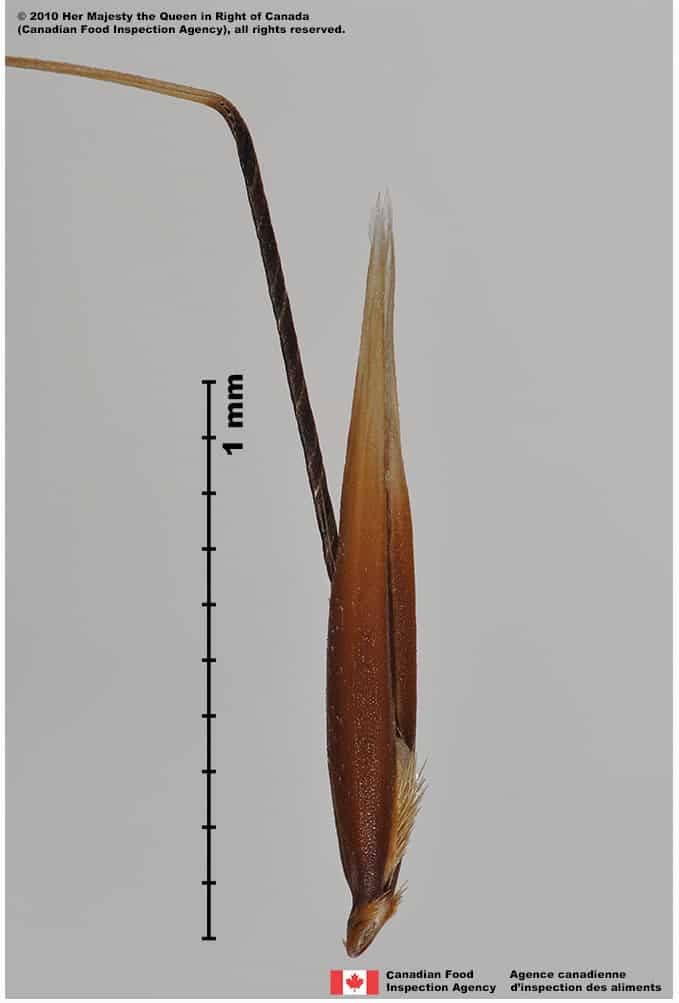
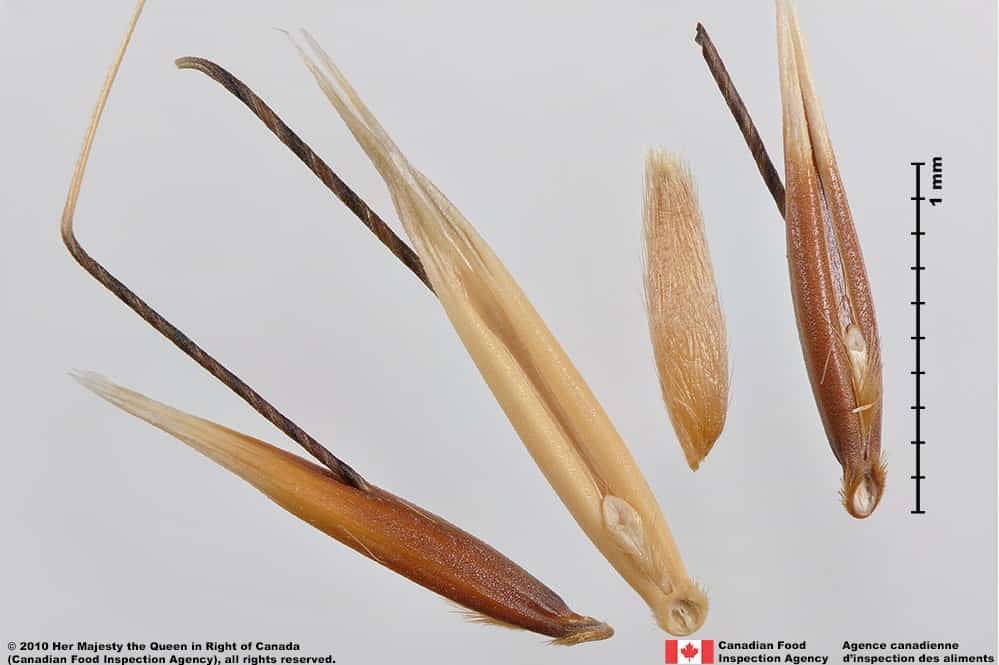
-
Caryopsis
Size
- Caryopsis length*: 6.0 – 8.0 mm; width: 2.0 – 3.0 mm
*Note: minimum and maximum of 10 caryopses in a normal range of this species using specimen measurement (ISMA 2020)
Shape
- Caryopsis is long oval shaped
Surface Texture
- Caryopsis is covered with stiff hairs
Colour
- Caryopsis is dull straw-yellow coloured
Other Features
- Scutellum surrounding the radicle is absent on the caryopsis
- Caryopsis has an indentation where the awn arose from the lemma
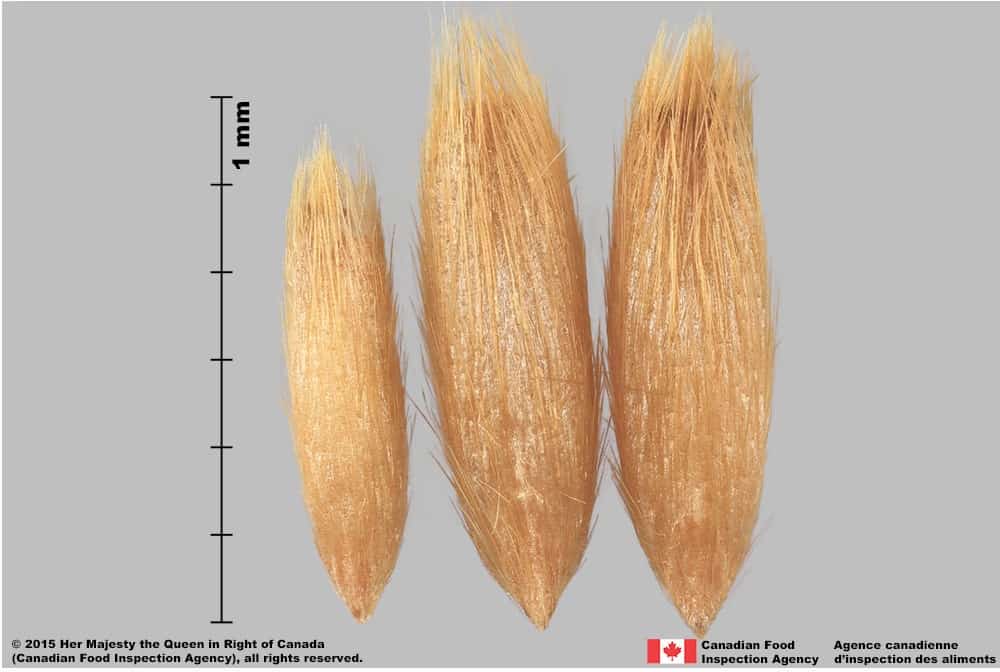
Wild oat (Avena fatua) caryopses, embryo view

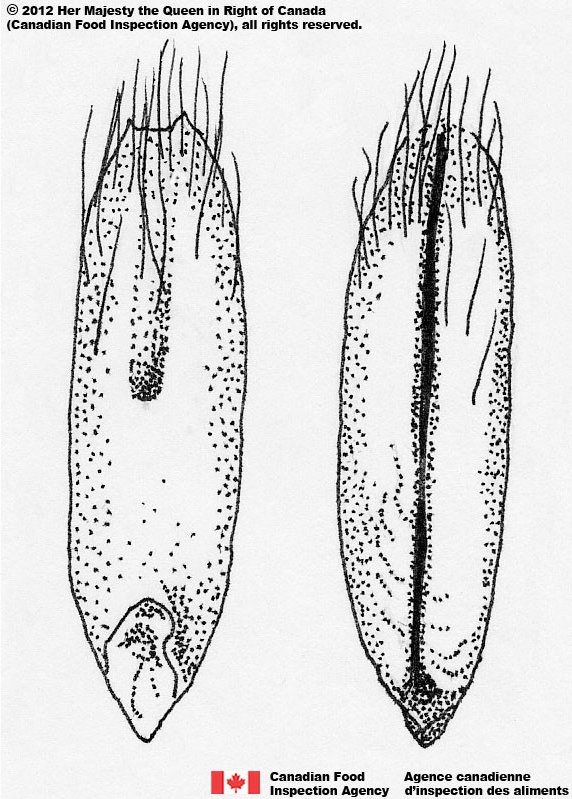

-
Embryo
Size
- Embryo is rudimentary compared to the size of the caryopsis
Shape
- Embryo is oval or wedge-shaped, in a lateral position at one end of the caryopsis
Endosperm
- Endosperm is soft and opaque white coloured

Wild oat (Avena fatua) floret, longitudinal section

Identification Tips
CONSEILS POUR L’IDENTIFICATION
Many Avena species have similar looking, long-oval shaped florets. A. fatua florets can be distinguished from similar species by a generally narrow floret that is shed separately when mature, and each floret has an oval or egg-shaped callus.

Wild oat (Avena fatua) floret, palea view






Additional Botany Information
AUTRES RENSEIGNEMENTS BOTANIQUES
Similar Species
ESPÈCES SEMBLABLES
Similar species are based on a study of seed morphology of various species, and those with similar dispersal units are identified. The study is limited by physical specimen and literature availability at the time of examination, and possibly impacted by the subjectivity of the authors based on their knowledge and experience. Providing similar species information for seed identification is to make users aware of similarities that could possibly result in misidentification.
Avena sativa L. (oat)
A. sativa florets are wider (width*: 2.7 – 3.7 mm) than A. fatua, with a uniform straw yellow colour (red-brown and grey varieties do exist), a smooth to slightly pebbled surface, a peg-shaped callus and occasionally a small awn. Unlike A. fatua, the A. sativa caryopsis has a scutellum around the embryo and lacks an awn indentation.
Avena sterilis L. (sterile oat)
The first floret of A. sterilis (length*: 15.0 – 35.0 mm; width: 2.3 – 4.0 mm) and second floret (length*: 10.0 – 14.0; width: 2.0 – 2.5 mm) are generally larger than A. fatua. The callus of only the first floret is egg-shaped, while the rest in the floret group are cylindrical, and dispersed as a group of 2-5 florets.
*Note: minimum and maximum of 10 florets in a normal range of this species using image measurement (ISMA 2020)
Click to select species
Cliquez pour sélectionner les espèces
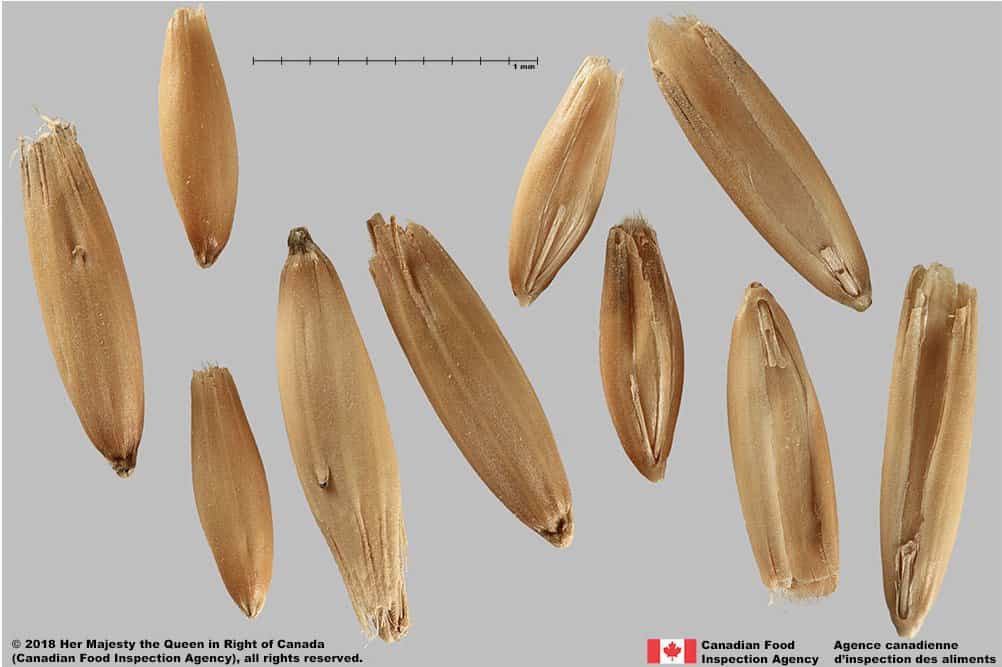
Avena sativa
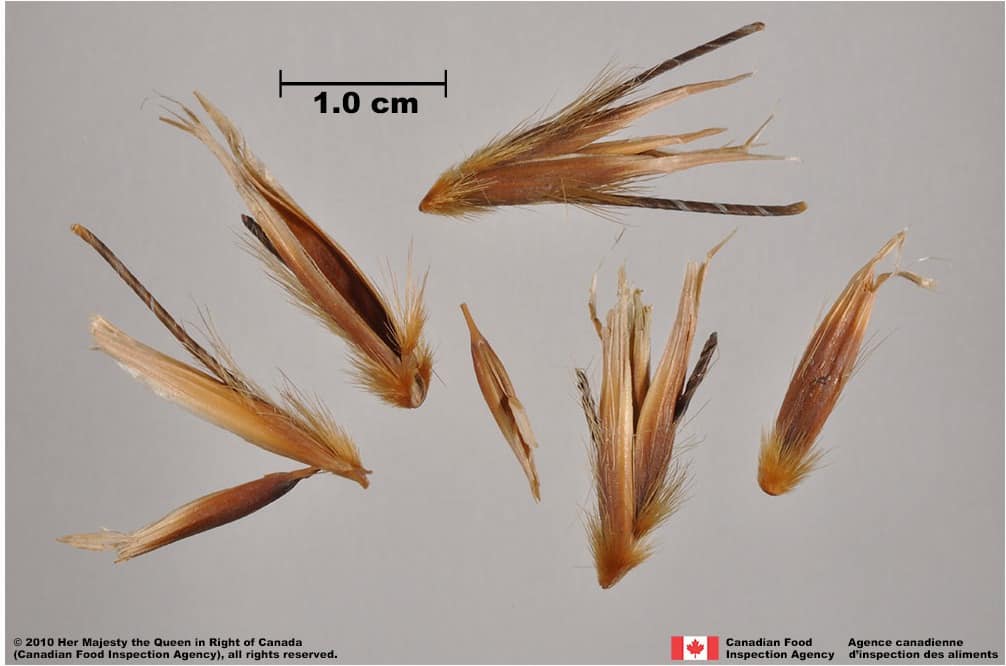
Avena sterilis
Comparison Window
Fenêtre de comparaison
MAIN SPECIES
ESPÈCES PRINCIPALES
Avena fatua

Avena fatua
Poaceae
Wild oat (Avena fatua) florets
MAIN SPECIES
ESPÈCES PRINCIPALES
Avena fatua

Avena fatua
Poaceae
Wild oat (Avena fatua) floret, side view
MAIN SPECIES
ESPÈCES PRINCIPALES
Avena fatua

Avena fatua
Poaceae
Wild oat (Avena fatua) floret, palea view
MAIN SPECIES
ESPÈCES PRINCIPALES
Avena fatua

Avena fatua
Poaceae
Wild oat (Avena fatua) floret, lemma view
MAIN SPECIES
ESPÈCES PRINCIPALES
Avena fatua

Avena fatua
Poaceae
Wild oat (Avena fatua) florets and caryopsis
MAIN SPECIES
ESPÈCES PRINCIPALES
Avena fatua

Avena fatua
Poaceae
Wild oat (Avena fatua) caryopses, embryo view
SIMILAR SPECIES
ESPÈCES SEMBLABLES
Avena sativa

Avena sativa
Poaceae
Tame oat (Avena sativa) florets
SIMILAR SPECIES
ESPÈCES SEMBLABLES
Avena sativa
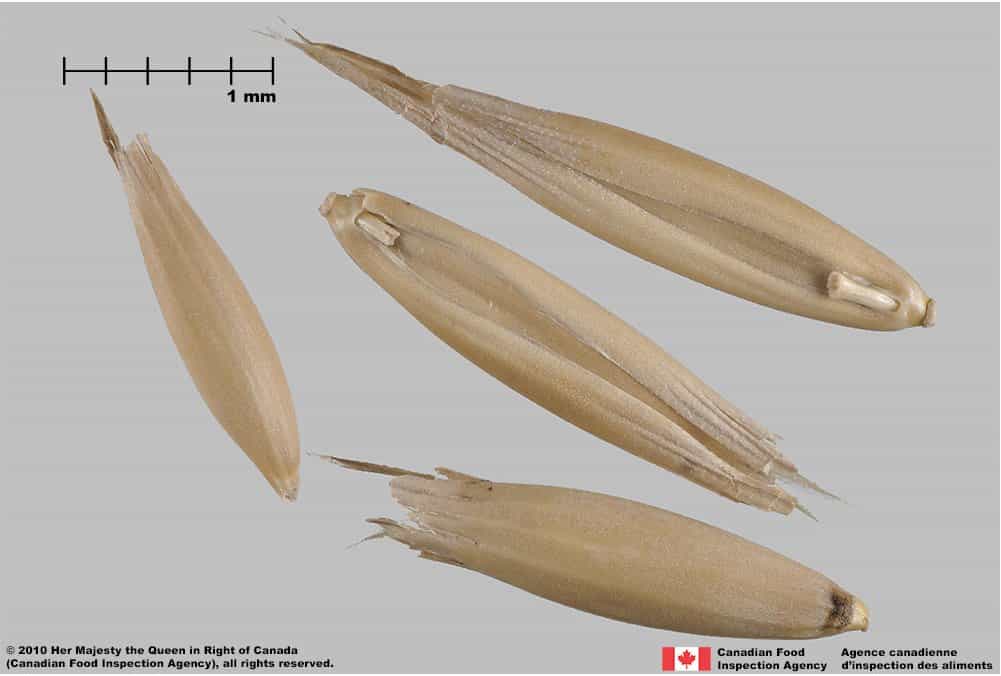
Avena sativa
Poaceae
Tame oat (Avena sativa) florets
SIMILAR SPECIES
ESPÈCES SEMBLABLES
Avena sativa
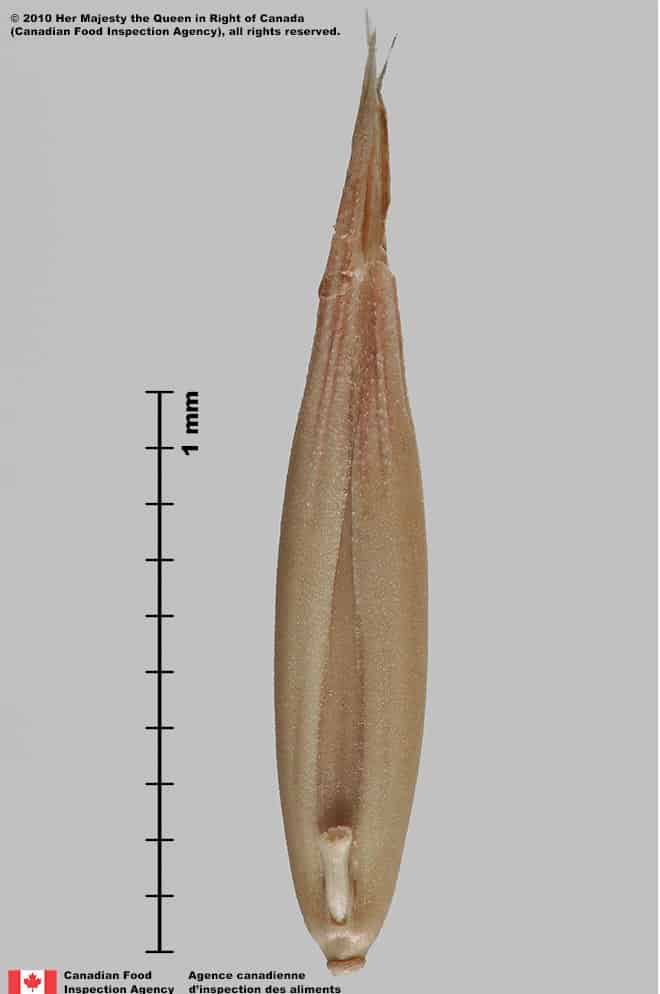
Avena sativa
Poaceae
Tame oat (Avena sativa) floret, palea view
SIMILAR SPECIES
ESPÈCES SEMBLABLES
Avena sativa

Avena sativa
Poaceae
Tame oat (Avena sativa) floret, lemma view
SIMILAR SPECIES
ESPÈCES SEMBLABLES
Avena sativa
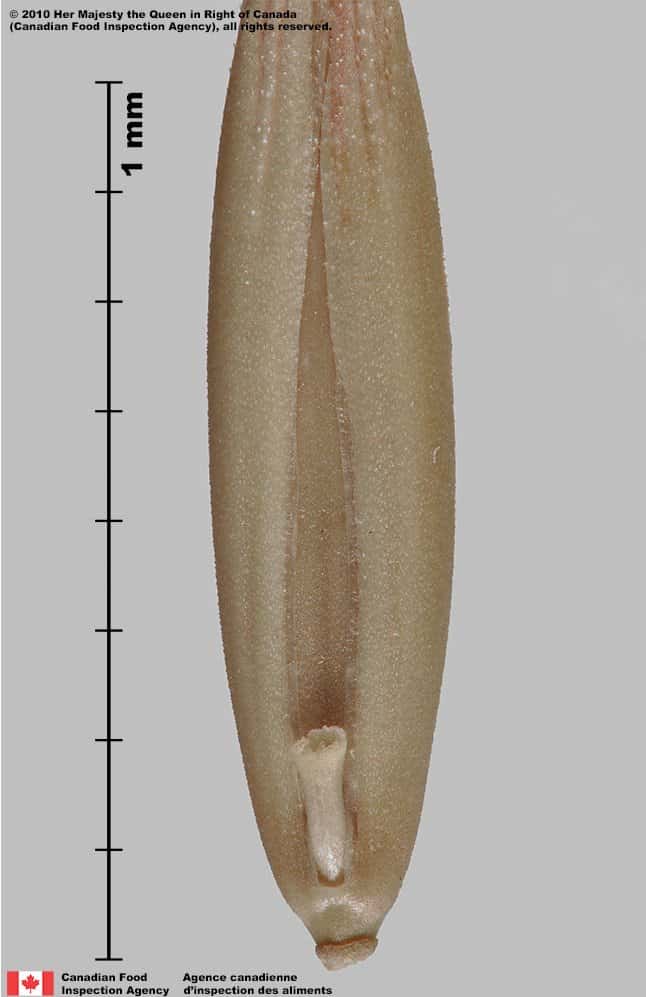
Avena sativa
Poaceae
Tame oat (Avena sativa) floret, palea view
SIMILAR SPECIES
ESPÈCES SEMBLABLES
Avena sativa
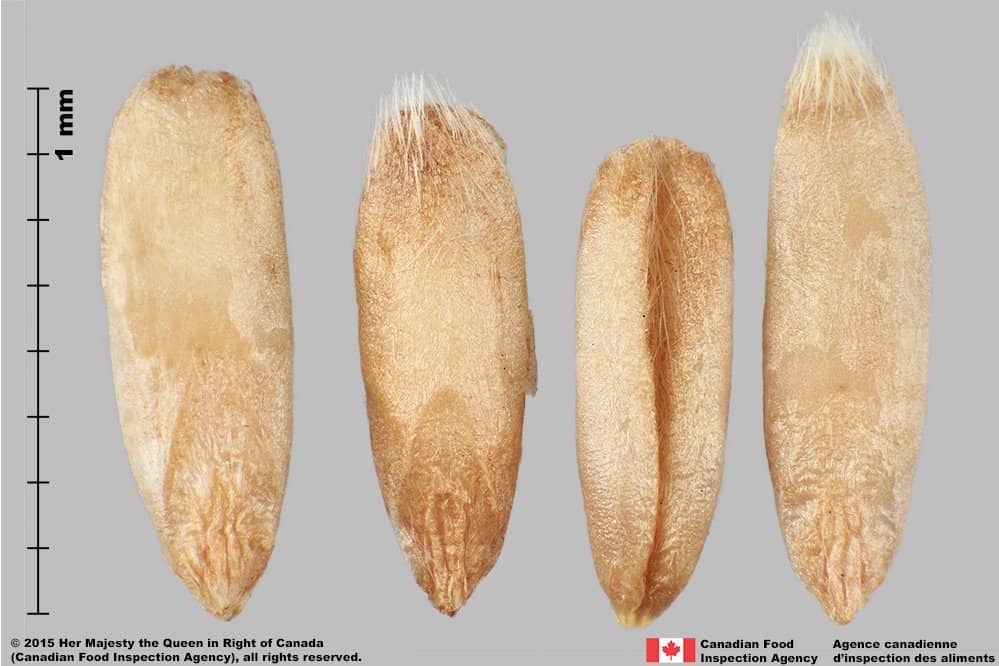
Avena sativa
Poaceae
Tame oat (Avena sativa) caryopses, embryo view and centre – hilum view
Need ID Help?
Besoin d’aide pour l’identification?
Reference(s)
Référence(s)
Barkworth, M. E., Capels, K.M., Long, S. and Piep, M.B. (eds.). 2007. Flora of North America Volume 24. Magnoliophyta: Commelinidae (in part): Poaceae, part 1. Oxford University Press, New York, New York.
Brouillet, L., Coursol, F., Meades, S. J., Favreau, M., Anions, M., Bélisle, P. and Desmet, P. 2010+. VASCAN, the database of vascular plants of Canada. http://data.canadensys.net/vascan/ Accessed December 29, 2020.
Centre for Agriculture and Bioscience International (CABI). 2021. Invasive Species Compendium, CAB International, Wallingford, UK. https://www.cabidigitallibrary.org/journal/cabicompendium Accessed March 3, 2021.
Darbyshire, S. J. 2003. Inventory of Canadian Agricultural Weeds. Agriculture and Agri-Food Canada, Research Branch. Ottawa, ON.
Kartesz, J.T. 2015. The Biota of North America Program (BONAP). North American Plant Atlas. Chapel Hill, N.C. http://www.bonap.net/napa Accessed March 3, 2021.
Flora of North America (FNA) Editorial Committee, eds. 1993+. Flora of North America North of Mexico [Online]. 22+ vols. New York and Oxford. Accessed December 29, 2022.
Global Biodiversity Information Facility (GBIF) Secretariat. 2022. https://doi.org/10.15468/39omei Accessed via https://www.gbif.org/species/2705297 Accessed December 29, 2022.
Government of Canada (GC). 2016. Canadian Weed Seeds Order. https://laws-lois.justice.gc.ca/eng/regulations/SOR-2016-93/page-2.html (English) https://laws-lois.justice.gc.ca/fra/reglements/DORS-2016-93/page-2.html (French)
International Seed Morphology Association (ISMA). 2020. Method for Seed Size Measurement. Version 1.0. ISMA Publication Guide. https://www.idseed.org/authors/details/method_for_seed_size_measurement.html
Sharma, M. P. and Vanden Born W. H. 1978. The biology of Canadian weeds. 27. Avena fatua L. Canadian Journal of Plant Science 58: 141-157.
U.S. Department of Agriculture-Agricultural Research Services (USDA-ARS). 2021. Germplasm Resources Information Network (GRIN), https://npgsweb.ars-grin.gov/gringlobal/taxon/taxonomysimple.aspx Accessed March 3, 2021.
U.S. Department of Agriculture-Natural Resources Conservation Service (USDA-NRCS). 2021. The PLANTS Database. National Plant Data Team, Greensboro, NC USA. http://plants.usda.gov Accessed March 3, 2021.



